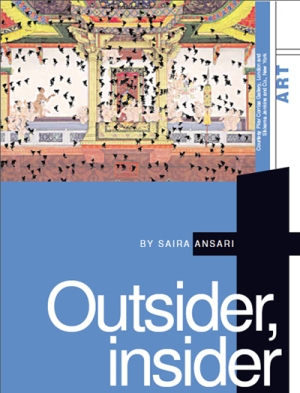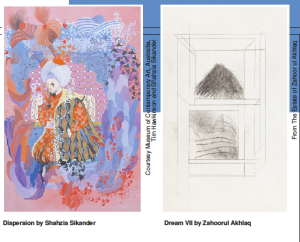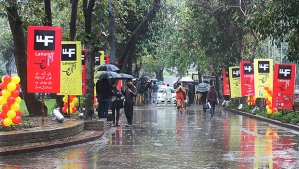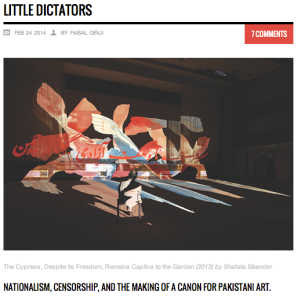OUTLOOK: WHAT WERE THE ISSUES THAT PAKISTANI ARTS GRAPPLED WITH IN 2014? The Herald Annual takes a look back on the year 2014 to see what were the big stories in Theatre, Films, Art, Books and Television. – Herald Annual Issue, January 2015

OUTSIDER, INSIDER
By Saira Ansari
The year 2014 has closed on an immensely dark note, with the terrorist attack on a Peshawar school casting a long and dark shadow on our reflections of achievements and losses on both a private and public level. It feels pertinent, then, to start an essay on the politics of identity in the art world with the very issue that plagues the whole nation — identity crisis.
Without creating confusion by spewing clichés, this article tries to take a circumstantial approach and looks at a few key events and published texts. These handpicked examples are by no means representative of identity politics and it is also quite likely that many other cases that fit the bill have been left out due to lack of space and time. It is, however, important to consider that the article references examples that have been the subject of much debate in multiple public forums in the recent past.
To tackle the most current manifestation of the subject of identity politics in art, it makes sense to start with the contentious Shahzia Sikander issue. For those not familiar with it, here is a brief background and context: Sikander is an artist with notable and consequential contribution to the neo-miniature movement. She started experimenting with miniatures in medium, scale and in the introduction of Western iconography back in the 1990s — about a decade before the current wave of contemporary miniature oeuvre started stemming from Pakistan. It is safe to say that her practice has been at the forefront of contemporising miniature painting, and catapulting it into the limelight in an international arena, as well as back home in Pakistan. The precedent, it can be rightfully argued, had been set by her teacher, Zahoor ul Akhlaq, an art star of now mythic proportions.
 Herein lies the supposed problem — Sikander left Pakistan to pursue a Masters degree in Fine Arts at the Rhode Island School of Design in 1995 and ended up staying and practicing in the United States. She engaged with the international audience at a time when the concept of a diasporic artist was still not clearly established, or even recognised, back home. In addition to that, many of Sikander’s interviews spoke about the blurring of boundaries and of working outside (and I paraphrase) the ghettoisation of South Asian artists in the postcolonial context. In a nutshell, her stance was clear about her work not being confined to any ethnographic labels applied to her. That, and the physical absence from Pakistan’s teaching field – a custom almost universal among practicing artists in Pakistan, especially those in Lahore – meant that she was slowly, but very surely, ostracised from the historical narrative of contemporary art in Pakistan over the years, one that has largely been based on anecdotal evidence. Students knew about her, artists spoke of her and there was a vague impression of her presence in the background, but she slipped through the cracks in lectures on contemporary art and lost significance in published texts about the art of the country. Post 9/11, when Pakistan was flung begrudgingly into the centre of the global stage, art from the country gained impetus and attention from newer audiences. Avenues for travel, production, collaboration and exhibition increasingly became accessible and a new wave of artists filled in these roles, leaving Sikander’s part of the story on the sideline.
Herein lies the supposed problem — Sikander left Pakistan to pursue a Masters degree in Fine Arts at the Rhode Island School of Design in 1995 and ended up staying and practicing in the United States. She engaged with the international audience at a time when the concept of a diasporic artist was still not clearly established, or even recognised, back home. In addition to that, many of Sikander’s interviews spoke about the blurring of boundaries and of working outside (and I paraphrase) the ghettoisation of South Asian artists in the postcolonial context. In a nutshell, her stance was clear about her work not being confined to any ethnographic labels applied to her. That, and the physical absence from Pakistan’s teaching field – a custom almost universal among practicing artists in Pakistan, especially those in Lahore – meant that she was slowly, but very surely, ostracised from the historical narrative of contemporary art in Pakistan over the years, one that has largely been based on anecdotal evidence. Students knew about her, artists spoke of her and there was a vague impression of her presence in the background, but she slipped through the cracks in lectures on contemporary art and lost significance in published texts about the art of the country. Post 9/11, when Pakistan was flung begrudgingly into the centre of the global stage, art from the country gained impetus and attention from newer audiences. Avenues for travel, production, collaboration and exhibition increasingly became accessible and a new wave of artists filled in these roles, leaving Sikander’s part of the story on the sideline.
 The debate over identity in art, however, continued and the Sikander issue resurfaced in a much talked about incident at the Lahore Literary Festival in early 2013 where art critic, teacher and artist Quddus Mirza said, at a panel discussion titled Polemics of Time and Space, that Sikander was not a Pakistani artist as she had not engaged with the Pakistani art community. The statement, although not made for the first time, received a fair amount of criticism from the audience in attendance. Following the event, the disapproval of his statement gained momentum and was recounted in everything — from casual conversations within the art fraternity, to blog posts and published texts. Many cried jingoism. Poignantly, it was the resultant discord which forced people to reconsider the ownership of narration and the formation of identity resulting from it, and to stand up against what was being considered a pigeonholed and political opinion of a few.
The debate over identity in art, however, continued and the Sikander issue resurfaced in a much talked about incident at the Lahore Literary Festival in early 2013 where art critic, teacher and artist Quddus Mirza said, at a panel discussion titled Polemics of Time and Space, that Sikander was not a Pakistani artist as she had not engaged with the Pakistani art community. The statement, although not made for the first time, received a fair amount of criticism from the audience in attendance. Following the event, the disapproval of his statement gained momentum and was recounted in everything — from casual conversations within the art fraternity, to blog posts and published texts. Many cried jingoism. Poignantly, it was the resultant discord which forced people to reconsider the ownership of narration and the formation of identity resulting from it, and to stand up against what was being considered a pigeonholed and political opinion of a few.
The questions that arise from this one example are many and complex. What are the characteristics that define a Pakistani artist? What is Pakistani art? Is there a singular definition of Pakistani art? Are there two, perhaps three, definitions? And finally, what are the precise indicators for the demarcation of art belonging to a certain space? There is even the risk of traversing into murkier waters — does an artist have a responsibility towards his/her country, culture, or audience? Keeping in tune with the intermediate level of this article’s dialogue, it is prudent to skip the beginners’ responses to these queries, per se. There are no clear answers stating ‘a is equal to b’. There are, however, understandings and approaches to these strains of interrogations — those that are best explored in sociological and anthropological contexts of identity in art history. To begin any such inquiry, however, one must be willing to accept the possibility of simultaneous conditions that coexist even when they are divergent from each other.
Which brings one to a more pressing concern — the commodification of identity and culture as the tour de force of contemporary art. In doing so, there is a risk of marginalising important and critical practices that are devoid of national narrative. That is to say, a Pakistani artist should hypothetically be able to make critically and/or commercially successful work about aliens from outer space, without ever referencing regional politics, history, culture, iconography or even any correlation with the current times. Why not? The act merely implies that the artist has an acute interest in aliens, and has explored it in a medium of his or her choice. The work could putatively be brilliant in thought, execution and presentation. It could then be presented at an international platform, and if one were to miss the small print indicating ‘Artist X lives and works in Pakistan’, the work would be unclassifiable as from, or about, Pakistan. In such a situation, does the artist become any less Pakistani? Does his/her educational experience and influences, as well as exposure to immeasurable local stimuli, become stripped of any significance? A reasonable, logical answer would be no. Does the work fit in the discourse of contemporary Pakistani practices? Yes. Would it work itself into a potential curatorial project on defining Pakistani response to global politics and its repercussions at home? Perhaps yes, that is, if the artist and curator thought it befitting; traditionally, maybe not.
Why, then, is the desire to cast the current and new breed of practitioners from Pakistan into a generic mould? This leads to the personal politics, briefly referred to earlier, as the anecdotal aspect involved in the writing of art history. The popular opinion is that the questioning of Sikander’s identity is a form of self-promulgation by a group of successful artists, who also teach, to create a lineage of a practice that they have fathered. Others suggest it is much more to do with isolating those voices and practices that have fallen out of favour with the key players in the art fraternity. Sikander has acknowledged this cold-shouldering on multiple public platforms and interviews, and more so since the 2013 incident. In an almost symbolic move, she was present at the 2014 edition of the Lahore Literary Festival, where she was given a stage to present her work and offer the local audience the chance to interact with her on a one-on-one basis. Several local publications used this opportunity to present ‘the other side of the story’ on the question of her identity but the heated politics of opinion was never far from this discourse.
 Also in February last year, Faisal Devji – a scholar of intellectual history, political thought and modern Islam in India, Pakistan and the Muslim world – wrote in Newsweek Pakistan about the exclusivist traditions of writing in the art history texts on Pakistani art. In specific, he chose to highlight the Sikander issue to comment upon the writings of three art historians and critics — Iftikhar Dadi, Virginia Whiles and Quddus Mirza. The article, however, assumed an accusatory tone even before it started — it was titled Little Dictators.
Also in February last year, Faisal Devji – a scholar of intellectual history, political thought and modern Islam in India, Pakistan and the Muslim world – wrote in Newsweek Pakistan about the exclusivist traditions of writing in the art history texts on Pakistani art. In specific, he chose to highlight the Sikander issue to comment upon the writings of three art historians and critics — Iftikhar Dadi, Virginia Whiles and Quddus Mirza. The article, however, assumed an accusatory tone even before it started — it was titled Little Dictators.
While Devji brought up a host of crucial points, basing his premise on the very legitimate argument of Sikander’s absence from critical text, he ended up rubber-stamping the text as personal vendetta. The article appeared as if from thin air, with little paper trail on the writer’s attempts at partaking in this discourse earlier. One can imagine that if he had refrained from making unusual accusations (that went as far as claiming that Dadi indulged in sectarian partisanship) and provided a meeting ground where he asked for a scholarly response from either of the parties he mentioned, the dialogue would have been more helpful. Rather than letting the reader focus on the strength of his claims, his piece ended up culling the response: What is the story that lies behind such a sudden and caustic attack? There is much to glean from the responses that followed by Dadi and then Whiles. These were posted in the comment section of the online version of the article, and also shared on various social media platforms. Dadi engaged the article in a point by point defence, providing reasonable arguments for the most part but also expressing outrage over the “unbalanced attacks on the too few…who are seriously committed to the art history of Pakistan”. He perhaps was seeking immunity for the privilege of belonging to the small club. Whiles’ response mostly only carried her outrage, with not enough context to convince an unbiased audience willing to give each party the benefit of the doubt to explain themselves.
This chain of events and the countless conversations it has started or ended in the past two years forces us to evaluate what is happening around us far more critically, starting with analysing what is being taught at art schools. The art world is seen gripped in the fast-paced throes of the capitalist success format, where the financial worth of art stands in for its critical worth. This is also trickling into education modules where students aspire to reach that level of success as achieved by their teachers, and there is no theoretical argument presented to them that will inform them otherwise. Therefore, there is a real risk of the current market trend – which in the last decade or so is based on an incredibly fetishised consumption of the Pakistani-ness of art, both in style and content – dictating the way students perceive, process and digest the production of a Pakistani identity within art.
To sum up, the deliberations around identity politics in the Pakistani art world are akin to a nationalistic debate. But the trouble with nationalism is that it is not inclusive, positions everything under blanket definitions, rejects minorities, and is not open to the idea of blurring boundaries to move towards a broader dialogue. In order to foster progressive trajectories in art practice, art theory and the writing of art history, we must be able to move beyond limiting definitions and tropes that have been passed down to us in Chinese whispers. It is not an inheritance we must accept as gospel, without the resolve to understand the nature of it, or to investigate alternate realms of thought.
![]()



















